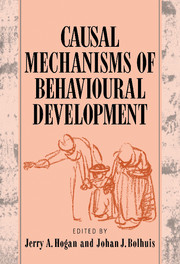Book contents
- Frontmatter
- Contents
- List of contributors
- Foreword: Introducing Jaap Kruijt
- Preface
- Part one Introduction
- Part two Development of perceptual and motor mechanisms
- Part three Development of behaviour systems
- 8 The ontogeny of social displays: interplay between motor development, development of motivational systems and social experience
- 9 Psychobiology of the early mother–young relationship
- 10 Development of behavior systems
- Part four Development of cognition
- Part five Learning and development
- Author index
- Subject index
9 - Psychobiology of the early mother–young relationship
Published online by Cambridge University Press: 19 January 2010
- Frontmatter
- Contents
- List of contributors
- Foreword: Introducing Jaap Kruijt
- Preface
- Part one Introduction
- Part two Development of perceptual and motor mechanisms
- Part three Development of behaviour systems
- 8 The ontogeny of social displays: interplay between motor development, development of motivational systems and social experience
- 9 Psychobiology of the early mother–young relationship
- 10 Development of behavior systems
- Part four Development of cognition
- Part five Learning and development
- Author index
- Subject index
Summary
This chapter is concerned with the development of interactions between mammalian mothers and their infants, especially rat and human mothers and their young. We first consider the hormonal and experiential factors that determine the mother's earliest responses to her newborn. We then focus on the infant and the events that control and guide its changing responses to its early social and physical environment. Throughout, we emphasize the ways in which the behavior of the mother and infant are complementary and mutually dependent, and are based on experiences acquired during the interaction.
As an example of complementarity between mother and infant, consider maternal retrieving behavior. When leaving the nest to retrieve her young, the female moves slowly in a low body position along a seemingly random path until she reaches her hidden pup. At that time, she lifts the pup by the nape of the neck, turns directly to the nest, and with head held high, she returns directly to the nest in a canter-like motion keeping the pup well above the substrate. For their part, the pups become limp and offer no resistance to movement when picked up by the scruff of the neck by dams (or by sharp, tooth-like tweezers by experimenters, Brewster & Leon, 1980). Lifting pups by other parts of the body causes them to twist and squirm. On such occasions that we have seen mothers hastily retrieve pups by parts other than the nape of the neck, the pups were dragged along the substrate.
- Type
- Chapter
- Information
- Causal Mechanisms of Behavioural Development , pp. 212 - 241Publisher: Cambridge University PressPrint publication year: 1994
- 6
- Cited by



